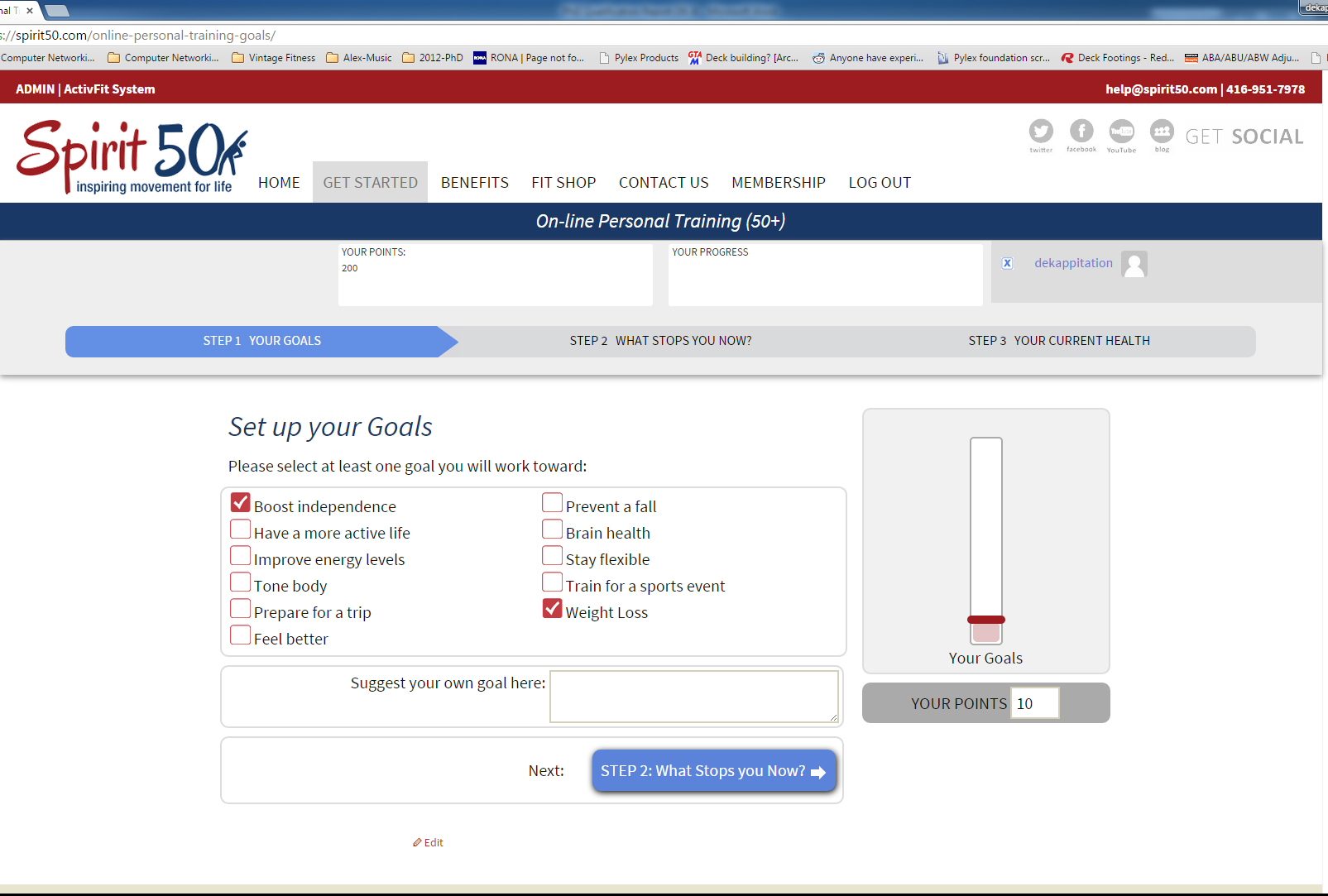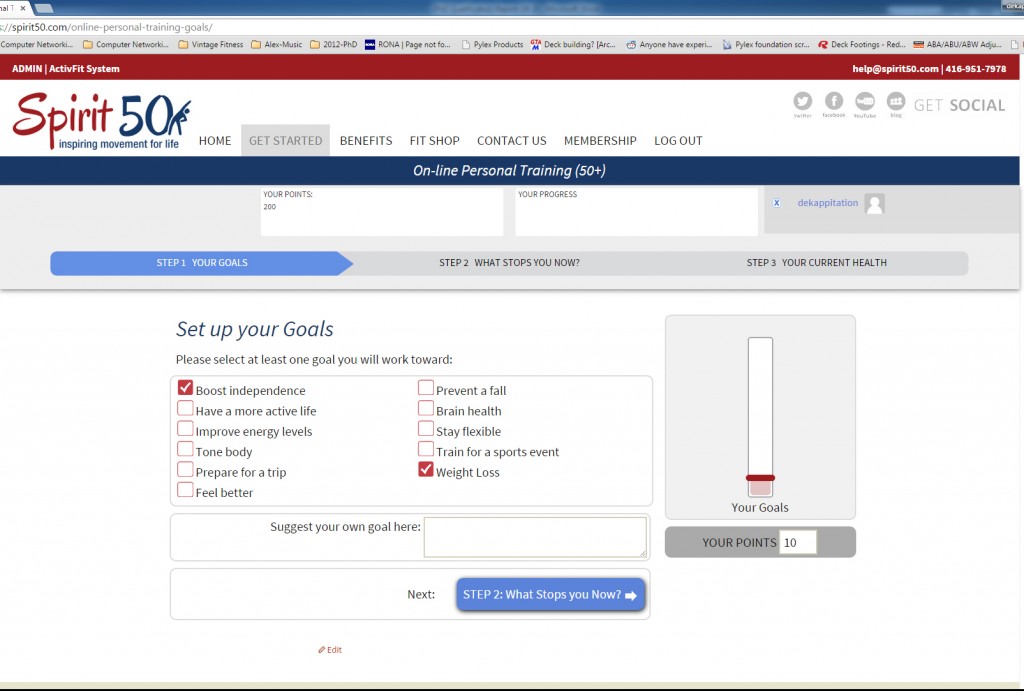Written by Dennis L. Kappen and Lennart E. Nacke
HCI Games Group collaborated with Erin Billowits, founder and owner of Vintage Fitness, a Toronto based health and wellness company catering to the fitness training needs of adults of age 50 years and older. Vintage Fitness aimed to engage older adults in daily exercise routines by catering to the specialized needs of the demographic and tailoring fitness routines based on health conditions of older adults. The HCI Games Group studied the motivations of older adults to engage in physical activities through empirical research focused on their intrinsic and extrinsic motivations to participate in physical activities.
Spirit50 was the culmination of analyzing rich qualitative data about older adults motivations to exercise and implementing an online application catering to older adults fitness with considerations to the physical and technological barriers commonly experienced by an older demographic. In an increasingly digital world, it can be difficult to engage an aging population in the online marketplace while ensuring effective, clear communication with customers and an easily understandable user interface. The online application proposed a novel approach involving the concept of gamification [1] by leveraging the intrinsic motivations [2][3] of older adults to engage in physical activity. By adding elements of tangibly measured progression and a rewards-based completion system, the task of becoming physically fit was made to be entertaining and fun for the participant.
This entertainment aspect of watching their progression through the exercise routines created a novel value for the customer, serving to incite their interest, guaranteeing their continued commitment to the fitness program. Hence, the applied principles of gamification in a technological context created a framework which enticed individuals participating in the program to continue their participation on a paid basis. The gamified system solves a twofold problem from a business perspective: the difficulty of exciting an older user base about a technologically founded product, and the challenge of ensuring that the service stood out among its competitors.
Gamification is still an emerging field, and thus, the application of its principles in a commercial context is relatively new. As such, the motivational schema and mechanics of progression that were developed through empirical research [2] to support the game-like aspects of this program required a great deal of development and technical refinement. Embedding these mechanics in a usable framework [3] presented further challenges from a programming and design standpoint. Consequently, the fitness application required the successful application of several skills to solve a number of challenges relating to the effective integration of the desired features with respect to usability, appeal, and gamification.
Firstly, the Spirit50 online fitness application used gamification to take advantage of inherent characteristics of progression and self-improvement within fitness training and maintenance. By their very nature, exercise programs possess quantifiable progress metrics in the number and intensity of exercises that an individual is able to complete. Secondly, this application used personalized fitness programs to give users an engaging and game-like experience, providing specific objectives and progress visualizations to motivate participants to achieve their goals. Additionally, most market offerings relied on generalized fitness solutions which did not cater to the specific needs, motivations, and challenges of particular individuals. Hence, the customized approach taken by this fitness application ensured that the business would be able to effectively set itself apart from the competition, and provided a unique value proposition to customers and the business enterprise.
The Spirit50 website catalogs a large collection of exercises related to various aspects of physical fitness. Based on the relative desired intensity level and overall health goal selected by the website user, a fitness schedule with specific exercises and beneficial tips is recommended. Integrated tools allow users to track their progress and access instructional photos and videos to assist them in meeting their fitness objectives.
Patterns of exercise routines are categorized based upon a collection fitness goals, such as reducing joint pain, improving cognitive health, and increasing mobility. The exercise “roadmaps” on the site are comprised of approximately 1200 various daily routines involving several hundred different exercise variations. Currently, the site integrates a custom database to manage the content of the exercise programs delivered via a web interface that allowed personalization and customization of fitness activities based on user selections of their motivations.
Involvement:
Dr. Lennart Nacke‘s HCI Games Group at the University Waterloo is currently involved in researching assistive playful technologies for enhancing the lifestyle of older adults. Dennis L. Kappen, PhD Candidate, working under his supervision, is researching game design and user interaction for older adults as part of his graduate thesis. Kappen and Nacke have also published works regarding the use of game design to engage older adults in fitness activities. Henk-Jan de Groot was the lead database designer, Samantha Stahlke was the database administrator, editor and debugging specialist, and, Tom Pace was the programmer on the project. This project was also made possible through the NSERC ENGAGE Grant.
References:
- Deterding, S., Dixon, D., Khaled, R., and Nacke, L.E. From Game Design Elements to Gamefulness : Defining “ Gamification.” MindTrek’11, September 28-30, 2011, Tampere, Finland., (2011), 9–15.
- Kappen, D.L., Nacke, L.E., Gerling, K.M., and Tsotsos, L.E. Design Strategies for Gamified Physical Activity Applications for Older Adults. Proceedings of the Annual Hawaii International Conference on System Sciences-49, (2016), 1309–18.
- Kappen, D.L. and Nacke, L.E. The Kaleidoscope of Effective Gamification : Deconstructing Gamification in Business Applications. Gamification 2013, (2013), 119–122.




Hi Guys
Has more work been done on this as I very interested. Also tried accessing the Spirit50 site but redirects to something un-related, is it still operational in another form?
Hi Andrew. The company Vintage Fitness that we did the project with is still active. However, we also recently started a new project investigating a different augmented-reality approach for fitness for older adults called Exergetic that might be interesting to you.